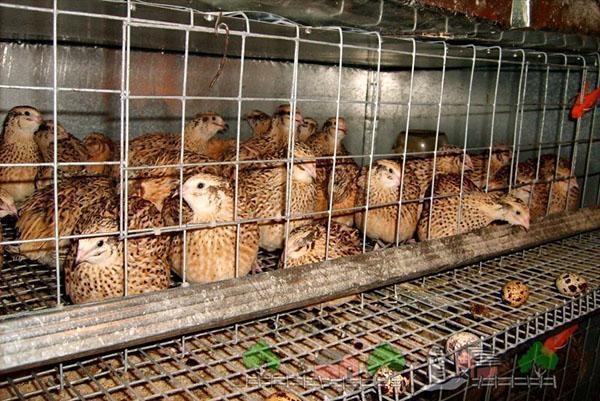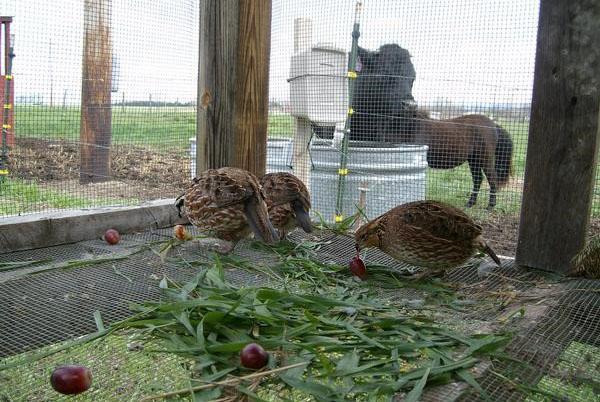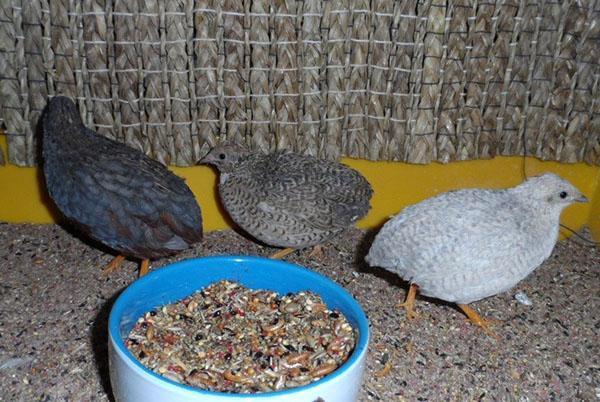Breeding quail at home
 Today, more and more people choose life in a private house for themselves, which involuntarily pushes them to the decision to start keeping livestock useful in the household. The smallest representatives of this vast family are quails. Breeding at home a rather unpretentious bird, responsive to care, is within the power of even beginners.
Today, more and more people choose life in a private house for themselves, which involuntarily pushes them to the decision to start keeping livestock useful in the household. The smallest representatives of this vast family are quails. Breeding at home a rather unpretentious bird, responsive to care, is within the power of even beginners.
Fried, baked with mushrooms and herbs, stuffed quails were served at the tables of the nobility in Medieval Europe and Russia. But if in those ancient times a quail hunt was equipped for several dozen carcasses, today these very small birds are successfully bred both in private farmsteads and in large poultry complexes.
Economic aspects of quail breeding
Interest in quails among amateur poultry breeders is caused by:
- insignificant costs of purchasing eggs for incubation;
- ease of keeping poultry;
- quick return on invested forces.
How to start breeding quail at home for novice poultry breeders? What difficulties await them, and what should be considered when creating your own miniature farm?
The bird is bred for two purposes:
- for the sake of dietary eggs, nutritional qualities, safety and a number of other indicators that are superior to chicken;
- for obtaining tender low-fat meat.
This should be taken into account when choosing the specialization of the future quail farm and deciding on the breeds for breeding.

Within a month and a half after the birth of the quail, they are ready to lay, and only 18 days pass from laying eggs in the incubator to hatching the chicks. Such early maturity "never dreamed" of chickens, which directly speaks of the economic feasibility of breeding quails at home.
Quail keeping conditions at home for beginners
If a chickens, ducks, geese and other birds are easily mastered in a backyard and can be raised using pasture rangings, but it is extremely difficult to domesticate quails. Therefore, this type of bird is kept in cages.
 A room for keeping quails in the country is chosen dry, ventilated and warm, but at the same time reliably protected from drafts, which birds cannot stand. For the active development and maintenance of egg production, birds need lighting. The optimum can be considered a 17-hour daylight hours:
A room for keeping quails in the country is chosen dry, ventilated and warm, but at the same time reliably protected from drafts, which birds cannot stand. For the active development and maintenance of egg production, birds need lighting. The optimum can be considered a 17-hour daylight hours:
- If the cages are lit for longer, the number of eggs will increase at first, but the bird is quickly depleted.
- Short daylight hours, without the use of additional lighting, will not give the desired results from layers and young stock. In the dark, birds are reluctant to feed, which leads to savings in feed, but at the same time inhibits growth.
The unpretentiousness of the bird, the small space occupied by the cells and the quick return of dietary products are the reasons for the popularity of keeping quails in the country, in a private house or even in an apartment.
However, breeding a large number of birds in a residential area is undesirable:
- due to the risk of developing diseases that are dangerous for both birds and humans;
- the difficulty of creating the proper conditions for lighting and ventilation;
- due to the imminent violation of the rules for the use of housing in apartment buildings.
 At the dacha or at his own backyard, a poultry farmer can grow a couple of generations of quails in one summer season and get healthy and tasty eggs from them. The only thing that may cause the need for additional costs is the breeding and maintenance of quails in the winter, however, a video about the organization of the process will help to understand the nuances to prevent mistakes even for novice poultry farmers.
At the dacha or at his own backyard, a poultry farmer can grow a couple of generations of quails in one summer season and get healthy and tasty eggs from them. The only thing that may cause the need for additional costs is the breeding and maintenance of quails in the winter, however, a video about the organization of the process will help to understand the nuances to prevent mistakes even for novice poultry farmers.
How to breed quail?
A home quail farm begins with the acquisition of weekly chicks or the incubation of young stock by yourself. The emerging quails require special care and conditions of detention. Before breeding quails, for tiny chicks, they build or acquire a draft-proof cage equipped with lighting and heating.
 Small quails in the first week of life need to maintain an elevated air temperature at 35–36 ° C. Then in brooder the air is gradually cooled, by the end of the second week it is brought to 30 ° C. It is important to arrange heating of small quails when breeding at home so that the temperature in the cage changes smoothly, without jumps that threaten the rapid weakening and death of the young.
Small quails in the first week of life need to maintain an elevated air temperature at 35–36 ° C. Then in brooder the air is gradually cooled, by the end of the second week it is brought to 30 ° C. It is important to arrange heating of small quails when breeding at home so that the temperature in the cage changes smoothly, without jumps that threaten the rapid weakening and death of the young.
 In addition to heat, the quails are left with round-the-clock lighting in the first two weeks. This technique allows you to stimulate the activity of the bird, it often approaches the feeders and develops faster. From 3 weeks of age, the chicks are gradually transferred to 12 hours of lighting. From 1.5 months, when the quails begin to lay, the birds are placed in cages with a 17-hour daylight hours.
In addition to heat, the quails are left with round-the-clock lighting in the first two weeks. This technique allows you to stimulate the activity of the bird, it often approaches the feeders and develops faster. From 3 weeks of age, the chicks are gradually transferred to 12 hours of lighting. From 1.5 months, when the quails begin to lay, the birds are placed in cages with a 17-hour daylight hours.
In the summer, birds can be taken out into the air, but there is no open range for quail. And here they are contained in mesh cells.
When keeping quails at home, novice poultry farmers need to pay special attention to the feeding regime and diet, as well as maintaining cleanliness in the cages. To make cleaning less hassle, the cages and baby brooder are equipped with a double bottom and made of materials that are easy to dry read and wet hygiene procedures.
Arrangement of cages for quails
Convenient drinkers are provided for feeding birds in places of detention. Vacuum-type constructions are highly desirable for young animals. For adult birds, you can leave existing equipment or install nipple drinkersthat do not give quails access to water. As a result, the drinking moisture will always be clean, and the quails themselves will not suffer from hypothermia.
 The number of drinkers and feeders for breeding quails at home is calculated based on the number of livestock so that in hot weather or during a mass meal, the pets do not quarrel over food and do not trample the weak. For chicks, tray feeders are installed in the brooder. As they grow older, they are changed to grooved structures outside the cells.
The number of drinkers and feeders for breeding quails at home is calculated based on the number of livestock so that in hot weather or during a mass meal, the pets do not quarrel over food and do not trample the weak. For chicks, tray feeders are installed in the brooder. As they grow older, they are changed to grooved structures outside the cells.
Keeping adult quails
At three weeks of age, the chicks are placed in adult cages. Females prepare to become laying hens, and males are sorted for breeding and fattening for meat. At this point, there are changes in the diet.
Protein-rich components are added to quails intended for breeding at home when feeding. This will help future laying hens to increase egg production, and male quails gain weight faster. By one and a half months, young livestock are divided according to gender and parental groups or families are formed, and experienced poultry farmers advise taking a pair of males for eight quails. In this case, the selected individuals are immediately placed in one cage. Subsequently, it is better not to change males, since chickens perceive this very sharply and can even cripple a beginner.
 If a group is formed only from layers, then a strong active male can be added to them as needed. In this case, it is easier to control which birds are covered, and egg production is higher with proper supervision.
If a group is formed only from layers, then a strong active male can be added to them as needed. In this case, it is easier to control which birds are covered, and egg production is higher with proper supervision.